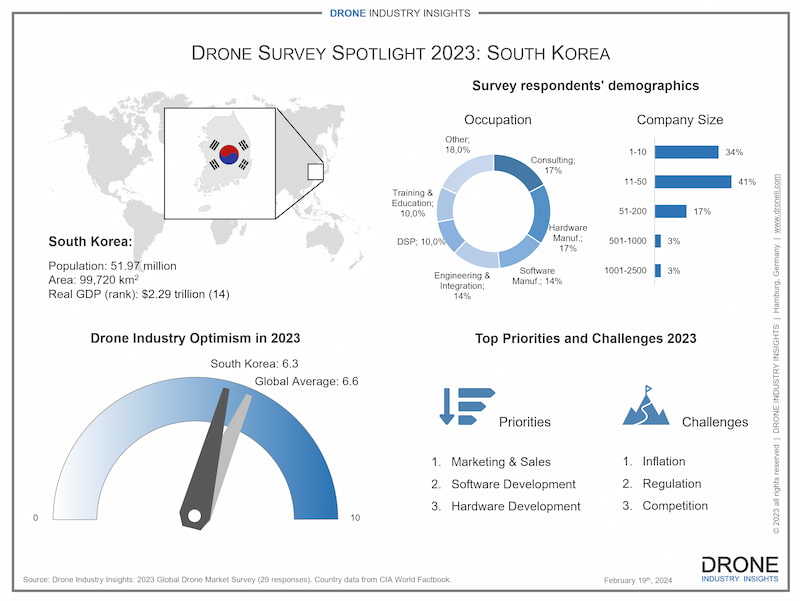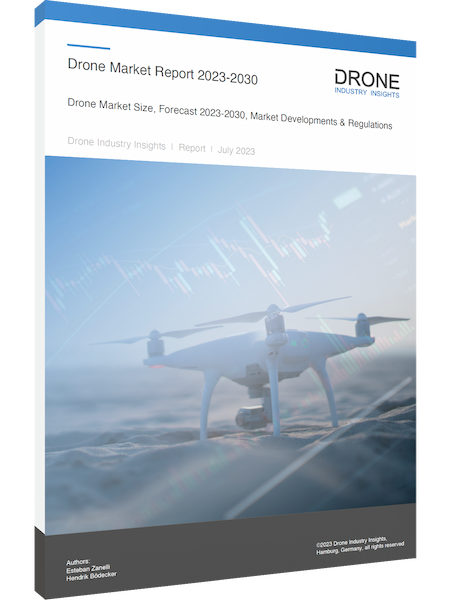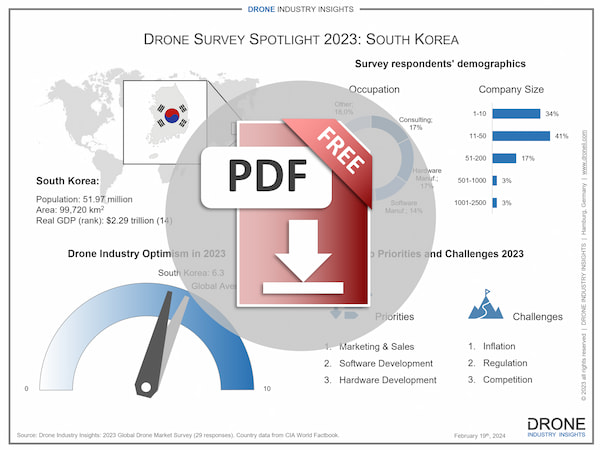Survey Snapshot: the South Korean Drone Market
Note: The following information about drone companies in South Korea is based exclusively on data from our latest drone industry survey and is not a comprehensive drone market study. Therefore, it should be interpreted as a glimpse into the South Korean drone market rather than in-depth authoritative research. For a more thorough study, please contact info@droneii.com
Despite the omnipresence of Chinese and Japanese neighbors, the South Korean Drone Market is also a strong player in the global drone economy. A quick search for commercial drone activity in South Korea reveals examples such as a drone show to celebrate the Year of the Dragon, and the announcement of new counter-drone technology which, although more military-oriented, still provides an interesting development for those interested in countering drone activity. Recently, drone soccer, a South Korean invention, showcased a match at CES 2024 in Las Vegas to help promote the first-ever drone soccer World Cup (to be held October of 2025 in South Korea).
As if all of this weren’t enough, South Korea also created the first hydrogen fuel cell drone, and in terms of operations, there will be an expansion of drone deliveries of food and essential items from Busan. And all of this is on display right now precisely in Busan at the annual Drone Show Korea 2024. This year’s theme is caring for the world through boundless expansion, and since not everyone can be in Busan to enjoy this fantastic gathering, let us dive deeper into the composition and potential of the South Korean Drone Market.
Opportunity for Drones in South Korea
With a population of 51.97 million in an area of roughly 100,000 km², South Korea is among the more densely populated countries in the world. And despite its smaller size, it has a real GDP ranking in the global top 15 countries, which translates into high purchasing power. In other words, the country certainly has the financial capacity to be a leader in drone technology.
But what can drones be used for in South Korea? In addition to already-popular drone shows, South Korea also has plenty of forests and approximately 70% of the country is considered mountainous. This bodes well for the aforementioned drone deliveries since drones are capable of traversing these terrains faster and more efficiently than other services (think medical emergencies).
Additionally, the urbanization rate of 81.5% is not only another good sign for deliveries, but it also suggests that the areas outside of cities are not so densely populated, which means that there is plenty of space for drones to operate in Energy, Agriculture, and Construction operations (the top three global industries). Finally, with an aging population and plenty of infrastructure that needs to be sustained, there is a lot of potential for automation, and this is something drones can excel at.
* All country data from the CIA World Factbook
South Korean Drone Market Composition
This brings us to the topic of what drone companies in South Korea are already doing. Based on results from the latest Drone Industry Survey, there is a very high amount of diversity in the South Korean drone market, with no industry segment taking up more than 20%. The highest proportion of companies are either hardware manufacturers (17%) building drones for others or work in consulting (17%), sharing their advice and knowledge on the ins and outs of this competitive landscape. Closely behind these, we find software manufacturers (14%) and companies that specialize in adapting drones for special tasks through engineering & integration (14%).
Perhaps the most interesting observation here is that the two segments which are usually at the top of drone activities fall into fifth and sixth place within the Korean drone market. Drone Service Providers (DSPs), which are usually the most common type of drone company, represent only (10%) of drone companies in South Korea, while Training & Education companies also represent 10% (despite often being the second most common business focus).
And yet it is equally interesting to note that South Korea has a lot more mid-size drone companies than in the rest of the world. Although it is still the case that a majority of drone companies in South Korea have 50 employees or less (75%), there is a relatively high amount of companies with 50-200 employees (17%). In North America, this figure was only 9%, while the DACH Region only had about 6%. Essentially, medium-sized drone companies in South Korea are 2-3 times more common than in other wealthy economies, which is certainly a unique feature of the South Korean drone market.
Interested in the Commercial Drone Market? Check Out Our Latest Drone Market Report!
Drone Market Report 2023
• 227-page drone market report featuring:
• Commercial drone market + recreational drone market
• Breakdown of data by: segment, industry, method, region, and country
• Additional chapters on regulation and rising technology trends
Priorities and Challenges for Drone Companies in South Korea
Naturally, one drawback of having more medium-sized companies is an increased level of competition. South Korea is the first country in our country series where “Competition” ranks among the top 3 challenges. This is particularly interesting given the high amount of diversity in what companies do. To put it differently, if 60% of companies were DSPs then it would make sense to hear that competition is fierce, but as mentioned previously, no industry segment represents even 20% of the total, and drone companies in South Korea still perceive competition as a top 3 challenge, albeit the third-ranked one. The top challenge, inflation, is a temporary economic development while the second-ranked challenge is common across the globe (i.e. regulation).
What do drone companies in South Korea prioritize within this competitive landscape? Not surprisingly, the top priority in this market is also Marketing & Sales. After all, when competition is fierce, companies need to spend a lot of time and resources to stand out and increase their sales to solidify or expand their market position. Other top priorities are Software Development and Hardware Development, which once again suggests that the South Korean drone market is a bit more focused on producing drones themselves rather than selling them as a service.
Finally, two important points regarding proprieties and go beyond the results of the annual survey. The first is the importance of securing financial resources to continue growing. Many drone companies in South Korea find it difficult to acquire long-term contract funding, while others such as Pablo Air have chosen to prepare for an eventual IPO to expand their financial resources. Either way, increasing the amount of investment will be an important issue for South Korea. The second important issue for the South Korean drone market as a whole regards international growth. Although exports reached a level of US$11.1 million in 2023 and this was almost 5 times higher than the initial plan, it is nevertheless a sum that needs to continue to rise in order to realize the country’s full drone market potential.
South Korean Drones: A Competitive Landscape
The high amount of diversity and competition are likely among the core reasons why South Korea is also the first country in the country series where the level of optimism (6.3) is lower than the global average (6.6). To be clear, the optimism is still there and drone companies in South Korea are not pessimistic about the future. This is a fine yet fundamental difference because it shows that all things considered, the market as a whole has a positive outlook on the future.
All things considered; the South Korean Drone Market can perhaps best be summarized by one word: competitive. And here it is imperative to realize that competition is not always a bad thing, especially when it comes to innovation. Drone companies in South Korea are not only competing against each other to innovate and excel, they are also forced to compete with their powerhouse neighbors in China and Japan. By being and remaining “competitive”, these companies are showing that South Korean drones deserve a prominent place in Asia and the rest of the world.
Stay tuned as we continue to feature more countries and regions with unique and exclusive data from our annual Drone Industry Survey. If you are interested in learning more about the global drone market, you can find detailed data by sector, industry, method, region, and country in our flagship Drone Market Report.
And if you are interested in all the ins and outs of a particular region or country, including information on individual companies, you can contact us to discuss a comprehensive drone market study. Please contact info@droneii.com with the subject “Customized Drone Market Research”.
Download our FREE Drone Companies in South Korea Infographic
Our Infographic about drone companies in South Korea shows a market breakdown of what drone companies do, their size, top priorities and challenges. It also features an optimism meter comparing drones in South Korea with the rest of the world.

Before working with drones, Ed acquired vast experience in Communications and Diplomacy. He holds a Master’s in International Relations, Bachelor’s in Economics & Philosophy, and has lived in 7 countries.





